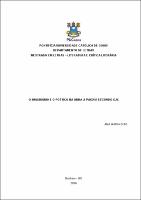| Compartilhamento |


|
Use este identificador para citar ou linkar para este item:
http://tede2.pucgoias.edu.br:8080/handle/tede/3245Registro completo de metadados
| Campo DC | Valor | Idioma |
|---|---|---|
| dc.creator | Dias, Ana Maria | - |
| dc.creator.Lattes | http://lattes.cnpq.br/2041161580319256 | por |
| dc.contributor.advisor1 | Lima, Maria de Fátima Gonçalves | - |
| dc.contributor.advisor1Lattes | http://lattes.cnpq.br/8056641507047911 | por |
| dc.contributor.referee1 | Cruz, Antonio Donizeti da | - |
| dc.contributor.referee1Lattes | http://lattes.cnpq.br/9408709557013563 | por |
| dc.contributor.referee2 | Pinto, Divino José | - |
| dc.contributor.referee2Lattes | http://lattes.cnpq.br/7196794396119181 | por |
| dc.date.accessioned | 2016-08-10T11:07:14Z | - |
| dc.date.available | 2016-03-11 | - |
| dc.date.issued | 2016-02-12 | - |
| dc.identifier.citation | DIAS, Ana Maria. O IMAGINÁRIO E O POÉTICO NA OBRA A PAIXÃO SEGUNDO G.H.. 2016. 95 f. Dissertação (Mestrado em Ciências Humanas) - Pontifícia Universidade Católica de Goiás, GOIÂNIA, 2016. | por |
| dc.identifier.uri | http://localhost:8080/tede/handle/tede/3245 | - |
| dc.description.resumo | A literatura moderna no século XX, especialmente o romance, passou por um processo radical de modernização, abdicando-se de vez das amarras do século XIX, que não a deixava fluir enquanto gênero. Uma das inovações dos autores contemporâneos foi a de narrar seus textos em primeira pessoa, facilitando, assim, a aproximação do leitor com o que estava sendo narrado. O objetivo desta pesquisa é analisar o imaginário e o poético no romance A Paixão segundo G.H., de Clarice Lispector, escrito em 1964. O primeiro capítulo desta pesquisa mostra a relação entre o poeta e o historiador, seguido da definição de imagem, imaginário e símbolo nas visões de Sartre, Bachelard e Durand. O segundo capítulo analisa a linguagem imagética da narrativa e, por meio desta, faz uma comparação entre o quarto, onde se encontra a personagem G.H, e o complexo de Jonas, tendo como suportes teóricos os mesmos autores do primeiro capítulo. Este capítulo ainda apresenta o insight da personagem narradora e o seu momento zênite. No terceiro capítulo, discute-se a poeticidade da obra. Para tanto, fez-se um estudo sobre a dimensão da linguagem poética e, em seguida, uma análise da linguagem metafórica na visão de Paul Ricouer e Octávio Paz, com o subtítulo Nem verdade, nem mentira: metáfora . Neste capítulo, além de discutir a linguagem imagética, são explorados também os sinais gráficos e os traços polissêmico e metafórico da obra para comprovar que esta é um poema em prosa. | por |
| dc.description.abstract | Modern literature in the twentieth century, especially the novel, underwent a radical modernization process, abdicating itself of the shackles of the nineteenth century, that did not let it flow as gender. One of the innovations of contemporary authors was to narrate his writing in first person, facilitating, thereby, the approach of the reader with what was being narrated. The objective of this research is to analyze the imaginary and the poetic in the novel Passion according to G.H., by Clarice Lispector, written in 1964. The first chapter of this research shows the relationship between the poet and the historian, then the image, imaginary and symbol concepts, according to Sartre, Bachelard and Durand. The second chapter analyzes the imagery language of the narrative. By means of the images, a comparison is made between the room, where G.H character is in, and Jonas complex, with the same view of the authors cited above. This chapter also presents the insight of the narrator character and her zenith moment. In the third chapter, the poeticity of the work is discussed. Therefore, a study was made about the dimension of poetic language and, then, an analysis of metaphorical language by Paul Ricouer and Octavio Paz, with the subtitle Nor truth, nor lie: metaphor . In this chapter, besides discussing imagery language, graphic signs and polissemic and metaphorical traces of the work were explored in order to prove it is a prose poem. | eng |
| dc.description.provenance | Made available in DSpace on 2016-08-10T11:07:14Z (GMT). No. of bitstreams: 1 ANA MARIA DIAS.pdf: 1030331 bytes, checksum: 81de7b911362ce538694cb2bcbc9d7c7 (MD5) Previous issue date: 2016-02-12 | eng |
| dc.format | application/pdf | por |
| dc.thumbnail.url | http://localhost:8080/tede/retrieve/9603/ANA%20MARIA%20DIAS.pdf.jpg | * |
| dc.language | por | por |
| dc.publisher | Pontifícia Universidade Católica de Goiás | por |
| dc.publisher.department | Ciências Humanas | por |
| dc.publisher.country | BR | por |
| dc.publisher.initials | PUC Goiás | por |
| dc.publisher.program | Literatura e Crítica Literária | por |
| dc.rights | Acesso Aberto | por |
| dc.subject | A Paixão segundo G.H. | por |
| dc.subject | Imagem | por |
| dc.subject | Imaginário | por |
| dc.subject | Metáfora viva | por |
| dc.subject | Passion according to G.H. | eng |
| dc.subject | Image | eng |
| dc.subject | Imaginary | eng |
| dc.subject | Living metaphor | eng |
| dc.subject.cnpq | CNPQ::LINGUISTICA, LETRAS E ARTES::LETRAS | por |
| dc.title | O IMAGINÁRIO E O POÉTICO NA OBRA A PAIXÃO SEGUNDO G.H. | por |
| dc.type | Dissertação | por |
| Aparece nas coleções: | Mestrado em Letras | |
Arquivos associados a este item:
| Arquivo | Descrição | Tamanho | Formato | |
|---|---|---|---|---|
| ANA MARIA DIAS.pdf | 1,01 MB | Adobe PDF |  Baixar/Abrir Pré-Visualizar |
Os itens no repositório estão protegidos por copyright, com todos os direitos reservados, salvo quando é indicado o contrário.




